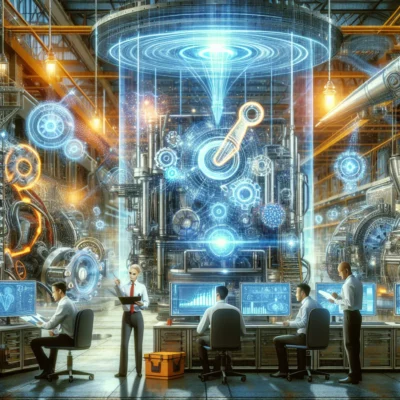In today’s fast-paced industrial landscape, the ability to foresee equipment failures and maintain operational efficiency is more crucial than ever. Predictive maintenance, powered by artificial intelligence (AI), is revolutionizing how industries approach equipment upkeep. This blog explores the transformative potential of AI in predictive maintenance, highlighting its benefits, challenges, and future prospects.
Understanding Predictive Maintenance
Predictive maintenance is a proactive approach that uses data analysis to predict when equipment failures might occur. This strategy allows companies to perform maintenance at just the right time, preventing unexpected breakdowns and minimizing downtime. Unlike traditional maintenance methods, which are either reactive (fixing equipment after it breaks) or preventive (scheduled maintenance regardless of equipment condition), predictive maintenance relies on real-time data to make informed decisions.
Traditional vs. Predictive Maintenance
- Reactive Maintenance: This approach involves repairing equipment after a failure has occurred. While it might save costs initially, it can lead to significant downtime and higher long-term expenses.
- Preventive Maintenance: Scheduled maintenance is performed at regular intervals, regardless of equipment condition. While it reduces the risk of unexpected failures, it can lead to unnecessary maintenance activities and costs.
- Predictive Maintenance: By leveraging data from sensors and advanced analytics, predictive maintenance identifies potential failures before they happen. This approach optimizes maintenance schedules, reduces costs, and extends equipment lifespan.
The Role of Data
Data is the backbone of predictive maintenance. Sensors on equipment collect vast amounts of data, including temperature, vibration, and pressure readings. This data is then analyzed to identify patterns and anomalies that might indicate an impending failure. The accuracy of predictive maintenance strategies depends heavily on the quality and quantity of data collected.
The Role of Artificial Intelligence
AI plays a pivotal role in predictive maintenance by enhancing data analysis capabilities. Through sophisticated algorithms, AI can process and interpret large datasets to predict equipment failures with remarkable accuracy.
AI Algorithms in Action
AI algorithms analyze historical and real-time data to identify patterns and predict potential failures. These algorithms can detect subtle changes in equipment performance that might go unnoticed by human operators. By continuously learning from new data, AI systems improve their predictive accuracy over time.
Machine Learning Models
Machine learning models are integral to AI-driven predictive maintenance. These models use historical data to train algorithms, enabling them to recognize patterns and make predictions. Common machine learning techniques used in predictive maintenance include:
- Regression Analysis: Predicts the remaining useful life of equipment based on historical data.
- Classification Models: Categorize equipment states (e.g., normal, warning, failure) to trigger maintenance actions.
- Anomaly Detection: Identifies deviations from normal operating conditions, signaling potential issues.
Real-World Examples
Several industries have successfully implemented AI-driven predictive maintenance. For instance, in the aviation sector, AI is used to monitor aircraft engines and predict maintenance needs, reducing flight delays and enhancing safety. Similarly, in manufacturing, AI systems analyze data from production lines to prevent equipment failures and optimize production schedules.
Benefits of AI in Predictive Maintenance
The integration of AI in predictive maintenance offers numerous advantages:
- Increased Efficiency: By predicting failures before they occur, AI helps maintain optimal equipment performance, reducing downtime and enhancing productivity.
- Cost Savings: Proactive maintenance strategies minimize repair costs and extend equipment lifespan, leading to significant cost savings over time.
- Enhanced Accuracy: AI’s ability to analyze large datasets with precision results in more accurate failure predictions, allowing for timely interventions.
Challenges and Considerations
Despite its benefits, implementing AI in predictive maintenance comes with challenges:
- Data Privacy and Security: The collection and analysis of large volumes of data raise concerns about data privacy and security. Companies must ensure robust data protection measures are in place.
- Skilled Personnel: Managing AI systems requires skilled personnel who understand both the technology and the specific industry context. Training and development are crucial for successful implementation.
- Initial Investment Costs: While AI-driven predictive maintenance can lead to long-term savings, the initial investment in technology and infrastructure can be significant. Businesses must weigh these costs against potential benefits.
The Future of AI in Maintenance
As AI technology continues to evolve, its impact on predictive maintenance will only grow. Emerging innovations, such as the Internet of Things (IoT) and edge computing, are set to enhance AI’s capabilities in this field.
Emerging Technologies
- IoT Integration: IoT devices provide real-time data from equipment, enhancing AI’s ability to predict failures accurately. This integration allows for more comprehensive monitoring and analysis.
- Edge Computing: By processing data closer to the source, edge computing reduces latency and improves the speed of predictive maintenance decisions.
Transforming Industries
AI has the potential to transform maintenance practices across various industries. From energy and utilities to transportation and healthcare, AI-driven predictive maintenance can enhance operational efficiency, reduce costs, and improve safety.
Preparing for AI-Driven Maintenance
Businesses looking to implement AI-driven maintenance solutions should start by assessing their current maintenance practices and identifying areas for improvement. Investing in the right technology and training personnel will be key to successful implementation. Collaborating with AI experts and technology providers can also help businesses navigate the complexities of AI adoption.
As industries continue to embrace AI, predictive maintenance will become an essential component of operational strategies. By leveraging the power of AI, businesses can unlock new levels of efficiency, reliability, and cost-effectiveness in their maintenance practices. The future of maintenance is here, and it’s powered by artificial intelligence.
